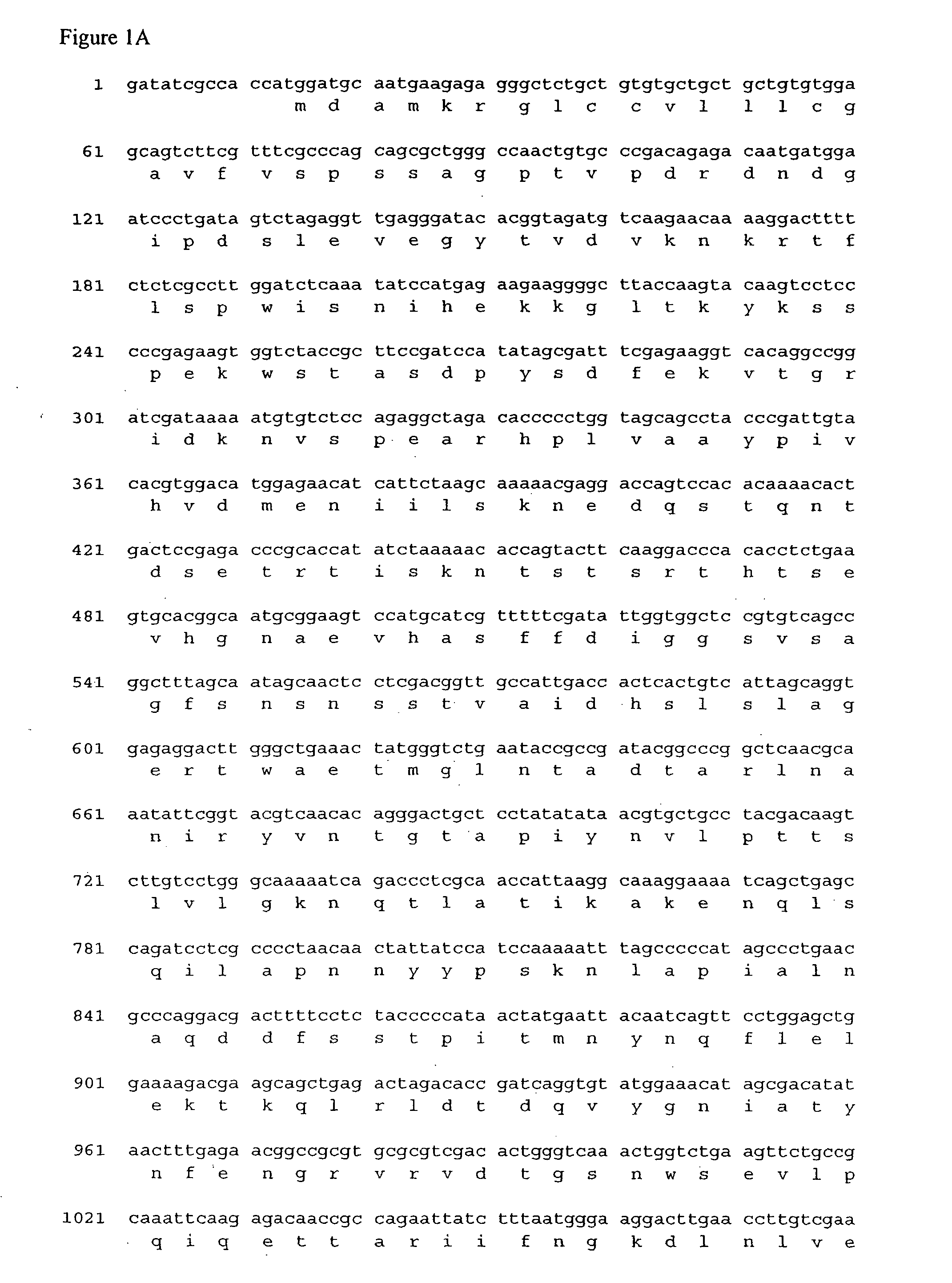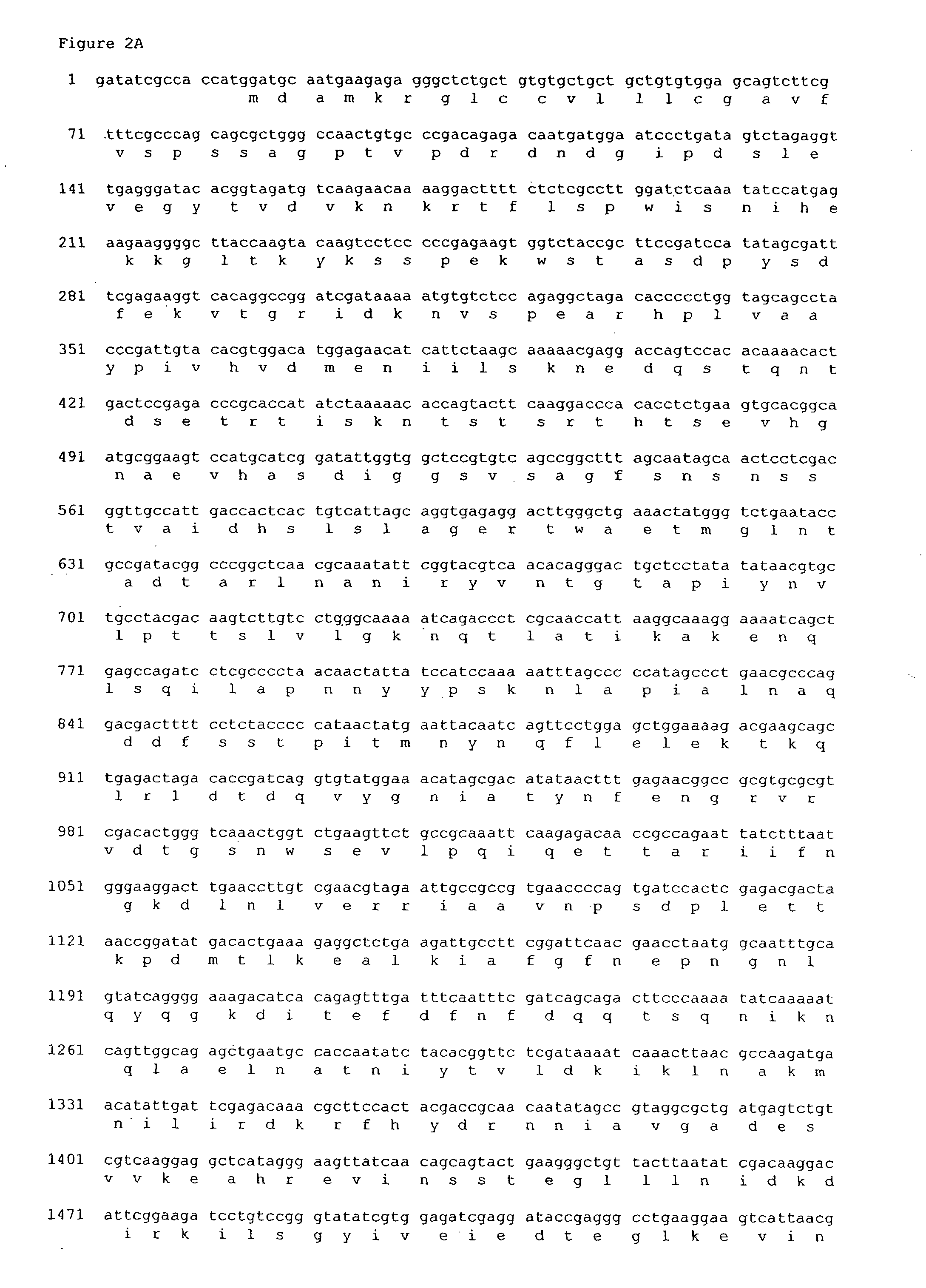Codon-optimized polynucleotide-based vaccines against Bacillus anthracis infection
a technology of bacillus anthracis and polynucleotide, which is applied in the direction of dna/rna vaccination, genetic material ingredients, antibody medical ingredients, etc., can solve the problems of less than optimal compliance and convenience of approved vaccination regimens, complex production process, and insufficiently characterized bacterial cell supernatant composition, etc., to enhance the immune response of a vertebrate, and enhance the immune response of a ver
- Summary
- Abstract
- Description
- Claims
- Application Information
AI Technical Summary
Problems solved by technology
Method used
Image
Examples
example 1
Construction of an Isolated Polynucleotide Comprising a Human Codon-Optimized PA Coding Region, Encoding the Full Length Bacillus Anthracis Protective Antigen (PA)
[0162] A representative native Bacillus anthracis protective antigen (PA) nucleotide sequence consists of nucleotides 1804 to 4098 of GenBank accession number M22589 version M22589.1 GI:143280 (SEQ ID NO:3). See Welkos, S. L. et al. Gene 69:287-300 (1988), which is incorporated herein by reference in its entirety. The PA sequence encodes a 764 amino acid (aa) precursor protein (SEQ ID NO:4) that is processed by a signal peptidase upon secretion by the bacteria, and also by host serum proteases (reviewed in Mesnage S., and Fouet, A. J. Bacteriol. 184:331-334 (2002), which is incorporated by reference herein in its entirety). The first 29 amino acids of PA encodes a bacterial signal sequence that is cleaved during secretion from the bacteria. In the host, furin-like serum proteases cleave off the N-terminal 258 amino acids ...
example 2
Construction of an Isolated Polynucleotide Comprising a Human Codon-Optimized LF Coding Region, Encoding the Full Length Bacillus Anthracis Lethal Factor (LF)
[0165] A representative native Bacillus anthracis lethal factor (LF) nucleotide sequence consists of nucleotides 685 to 3111 of GenBank accession number M30210 version M30210.1 GI:143141 (SEQ ID NO:11). The LF sequence encodes a 809 amino acid precursor protein that is processed to a 775 amino acid secreted protein by cleavage of its signal sequence. LF is a zinc metalloprotease that cleaves mitogen-activated protein kinase kinases (MAPKKs) contained inside target cells. See Mesnage S., and Fouet, A. J. Bacteriol. 184:331-334 (2002). Numerous mutations in LF have been described that eliminate zinc binding or the catalytic site of LF resulting in the loss of toxicity. See Hammond, S. E., and Hanna, P. C. Infect. Immun. 66:2374-2378 (1998). One form of inactive LF is described in detail herein, but all others could also be used ...
example 3
Construction of Plasmid Constructs Comprising Fragments, Variants, and Derivatives of a Human Codon-Optimized Coding Region Encoding Bacillus Anthracis PA
[0168] Several fragments, variants, and derivatives based on SEQ ID NO:23, the human codon-optimized coding region encoding Bacillus anthracis PA described in Example 1, were constructed in the following manner. Codon-optimized nucleic acid fragments encoding three alternate forms of PA were constructed, namely, a nucleic acid fragment encoding full-length PA minus the furin cleavage site (PA83Δ Furin), a nucleic acid fragment encoding the active furin cleavage product of mature PA (PA63), and a nucleic acid fragment encoding the active furin cleavage product of mature PA in which Phe 342 and 343 have been deleted (PA63ΔFF). Each of these nucleic acid fragments were fused in-frame to a nucleic acid encoding a human tissue plasminogen activator (TPA) signal peptide sequence that directs the expressed PA variants and / or fragments to...
PUM
| Property | Measurement | Unit |
|---|---|---|
| volume | aaaaa | aaaaa |
| molar concentration | aaaaa | aaaaa |
| mass ratio | aaaaa | aaaaa |
Abstract
Description
Claims
Application Information
 Login to View More
Login to View More - R&D
- Intellectual Property
- Life Sciences
- Materials
- Tech Scout
- Unparalleled Data Quality
- Higher Quality Content
- 60% Fewer Hallucinations
Browse by: Latest US Patents, China's latest patents, Technical Efficacy Thesaurus, Application Domain, Technology Topic, Popular Technical Reports.
© 2025 PatSnap. All rights reserved.Legal|Privacy policy|Modern Slavery Act Transparency Statement|Sitemap|About US| Contact US: help@patsnap.com



